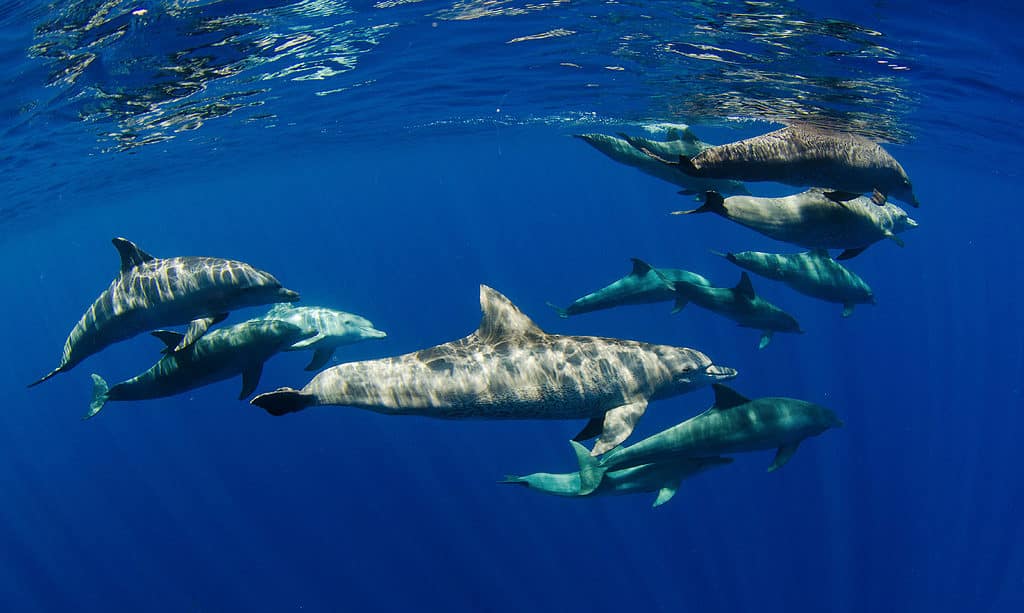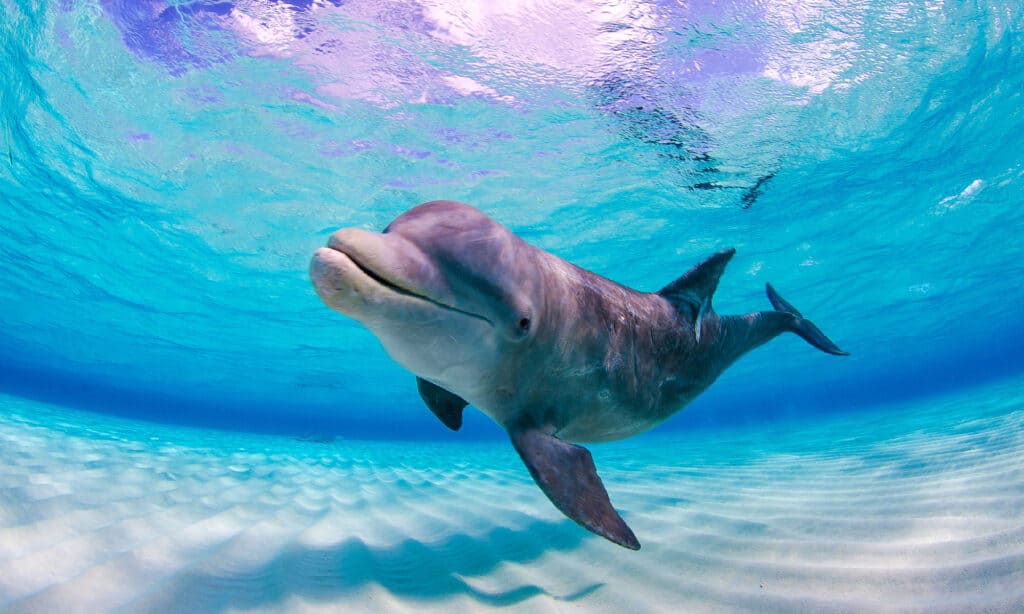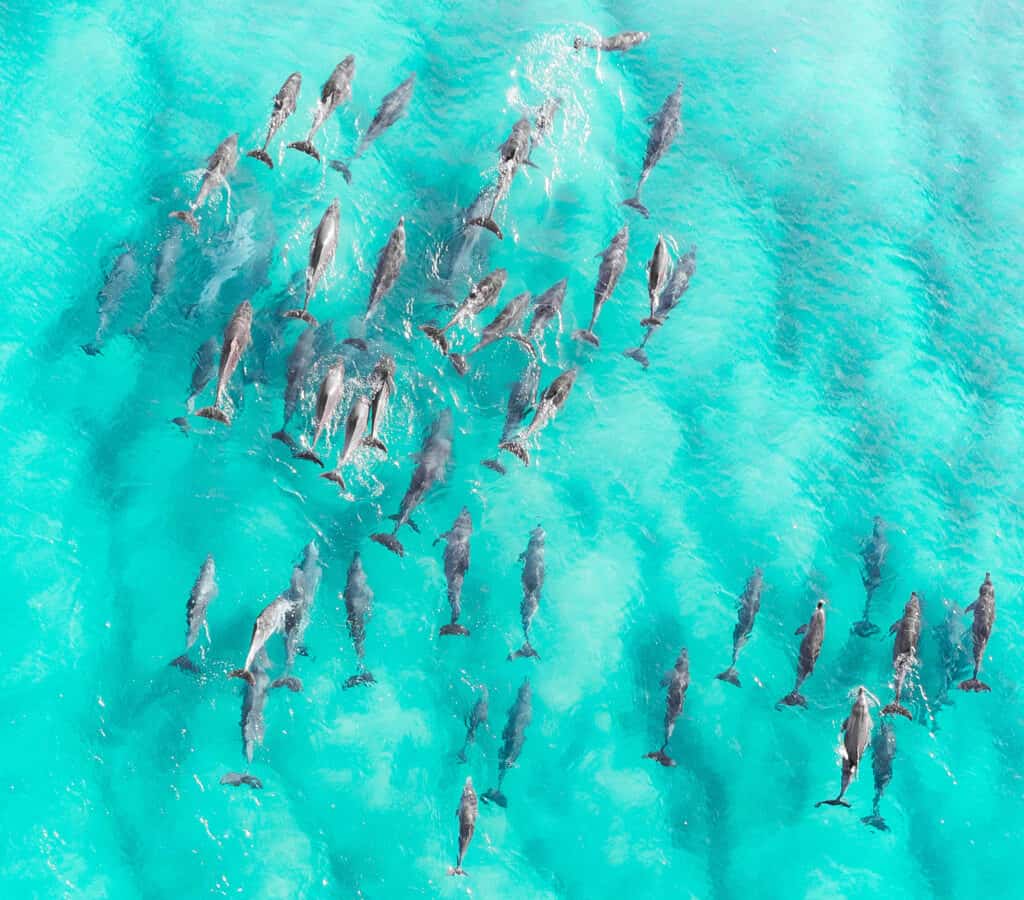Thanks to their fun personality and a high degree of intelligence, dolphins are among the most adored water creatures. Because of their need to go up for air and as a means of communication, these creatures are commonly seen leaping in Florida waters.
You might be curious about how long a dolphin can hold its breath. Dolphins can hold their breath underwater for as long as 20 minutes. Like all mammals, dolphins take their oxygen intake from the atmosphere.
In contrast to fish, which breathe through their gills when submerged, dolphins hold their air until they surface. Dolphins are very intelligent, thanks to a brain 25% heavier than humans. Their breathing pattern is intuitive and flexible depending on the activities going on at the time.
How Dolphins Hold Their Breath

How long can dolphins hold their breath underwater? The answer may surprise you.
©Joost van Uffelen/Shutterstock.com
Dolphins hold their breath when they swim into the water’s depths for fish. Dolphins may hold their breath for various amounts of time depending on a few different things. For instance, bottlenose dolphins can submerge for between eight and ten minutes.
A dolphin’s smaller bone structure enables them to slumber slightly below the surface even as they are sleeping. This enables them to periodically stir when sleeping to get the required oxygen. What other marine mammals can you name that are capable of breathing underwater?
Fin whales, for example, can only hold their breath for about 20 minutes, whereas some whale family members, like the sperm whale, can do it for up to 90 minutes. Elephant seals were considered the species best at submerging up until just a few years ago.
They can hold their breath for roughly two hours before coming up for air again if necessary. This fact didn’t change until a beaked whale was spotted during a two-hour, seventeen-minute dive. Contrarily, humans are only capable of holding out for about two minutes.
Dolphin Breathing Anatomy

Dolphins have a blowhole at the top of their heads, opening as they surface the air.
©iStock.com/Michelle de Villiers
Since dolphins are mammals, their bodies depend on breathing to function. Despite many believing so, dolphins’ blowhole is located at the top of their heads, not their nostrils. The blowhole opens as they surface for air, enabling these majestic creatures to breathe.
The blowhole firmly closes beneath a substantial muscle layer as they descend again. This stops water from getting inside. Like other animals, dolphins have lungs that are proportional to their bodies. Yet, the way dolphins’ lungs work is what distinguishes them from other species.
Dolphins, able to determine when to rise for air and breathe, are far more selective in their breathing than humans. The number of air sacs inside each lung is likewise significantly higher in dolphin lungs. This increases capacity while enabling them to pump oxygen more effectively into a more focused circulation process.
How Can Dolphins Sleep?

Dolphins sleep with half of their brain active.
©Andrea Izzotti/Shutterstock.com
As a result of our respiratory reflex, humans continue to breathe while we are asleep or unconscious. Dolphins cannot sleep in this manner; they must always be awake. Dolphins can only sleep with one-half of their brains active at once; the other half keeps the dolphin breathing and attentive to any threats in its environment.
Shockingly, these water mammals have to sleep with one eye open! The left eye will be shut when the right side of the brain rests, and vice versa. One brain hemisphere rests at a time during this type of sleep, called unihemispheric sleep.
These animals periodically switch which side of their brains is sleeping to obtain the required sleep without ever falling asleep.
Dolphins frequently lie still at the water’s surface while they sleep, breathing normally. They also occasionally move carefully and steadily at the surface while snoozing. Dolphins in shallow water occasionally rest on the seafloor before periodically coming to the top to breathe.
Why Can’t Dolphins Survive on Land?

Dolphins can dehydrate if they beach on land because they would lack the food and hydration they need.
©F Photography R/Shutterstock.com
Dolphins are unable to survive on land for a variety of reasons. The first requirement for dolphin survival is a constant supply of fish and other aquatic species. When looking for a particular diet that their bodies are accustomed to and can readily digest, dolphins have been known to dive up to 700 feet or more.
Dolphins would not be able to find the right kinds of food if they were to live on land. Even if they managed to locate food, there is no assurance that their body could digest it. However, there is a significant likelihood that their gastrointestinal tract would not be accustomed to it and might not be capable of absorbing it adequately, leaving the dolphin underweight and hungry.
Second, dolphins must maintain proper hydration to survive. Everyone who has witnessed a dolphin or whale beach understands how crucial it is for these animals to always be in the water.
Most beached dolphins can only endure on land for a few days before dehydrating, particularly in humid or hot areas. Finally, dolphins become immobile because they lack the limbs needed to walk on land.
The photo featured at the top of this post is © Andrea Izzotti/Shutterstock.com
Thank you for reading! Have some feedback for us? Contact the AZ Animals editorial team.






